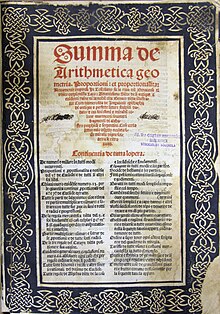Summa de arithmetica

Title page of second (1523) edition
|
|
| Author | Luca Pacioli |
|---|---|
| Country | Republic of Venice |
| Language | Italian |
| Subjects | Mathematics, Accounting |
| Publisher | Paganini (Venice) |
|
Publication date
|
1494 |
| Pages | 615 pp (first edition) |
Summa de arithmetica, geometria, proportioni et proportionalita (Summary of arithmetic, geometry, proportions and proportionality) is a book on mathematics written by Luca Pacioli and first published in 1494. It contains a comprehensive summary of Renaissance mathematics, including practical arithmetic, basic algebra, basic geometry and accounting, written in Italian for use as a textbook.
The Summa is the first printed work on algebra in a vernacular language, and it contains the first published description of the double-entry bookkeeping system. It set a new standard for writing and argumentation about algebra, and its impact upon the subsequent development and standardization of professional accounting methods was so great that Pacioli is sometimes referred to as the "father of accounting."
The Summa de arithmetica as originally printed consists of ten chapters on a series of mathematical topics, collectively covering essentially all of Renaissance mathematics. The first seven chapters form a summary of arithmetic in 222 pages. The eighth chapter explains contemporary algebra in 78 pages. The ninth chapter discusses various topics relevant to business and trade, including barter, bills of exchange, weights and measures and bookkeeping, in 150 pages. The tenth and final chapter describes practical geometry (including basic trigonometry) in 151 pages. The work was dedicated to Guidobaldo da Montefeltro, Duke of Urbino, a patron of the arts who Pacioli had met in Rome some years earlier.
The book's mathematical content draws heavily on the traditions of the abacus schools of contemporary northern Italy, where the children of merchants and the middle class studied arithmetic on the model established by Fibonacci's Liber Abaci. The emphasis of this tradition was on facility with computation, using the Hindu–Arabic numeral system, developed through exposure to numerous example problems and case studies drawn principally from business and trade. Pacioli's work likewise teaches through examples, but it also develops arguments for the validity of its solutions through reference to general principles, axioms and logical proof. In this way the Summa begins to reintegrate the logical methods of classical Greek geometry into the medieval discipline of algebra.
...
Wikipedia
